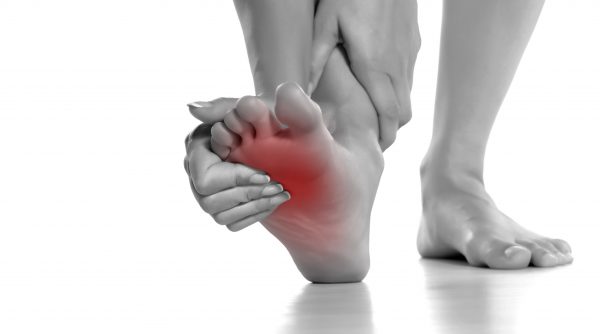Here you are again: coming home from a long day of work with pain in the balls of your feet.
It feels like you’re walking on a tiny marble and burns like you wouldn’t believe! Maybe your toes are even numb.
If you’re tired of the hurting in the ball of the foot, it might be time to seek a diagnosis. You could be suffering from a condition called metatarsalgia.

What is Metatarsalgia?
In layman’s terms, metatarsalgia (met-uh-tahr-SAL-juh) is the medical term for inflammation in the ball of your foot. It’s a foot condition named after the five “metatarsal” bones in the midsection of your feet that connect to your toes.
The inflammation of the tendons, ligaments and cartilage around your metatarsal bones is often the result of strain on your feet and manifests into a painful sensation whenever you apply pressure to the area.
Symptoms of Metatarsalgia
Have you been experiencing any of these problems with the balls of your feet?
- The sensation of walking on a marble or a pebble, even when barefoot
- An aching or burning in the ball of your foot
- A sharp, shooting pain in the ball of your foot
- Pain when you stand, walk, run or flex your feet— that dulls after rest
- Numbness or tingling in your toes
Another key symptom of metatarsalgia is a gradual build-up to worsening pain. This foot condition develops over time and usage (see Causes below), so you can expect the pain to get worse the more you irritate the ball of your foot.
What Causes Metatarsalgia?
Metatarsalgia is a common condition because it can be caused by so many factors, including:
- Overuse from training or activity. Are you a runner who puts your feet through repetitive motion and impact? Maybe you have a profession where you simply stand all day long. High-impact or straining pressure can cause metatarsalgia inflammation. Runners in particular are subject to developing many foot conditions.
- Stress fractures or injury. If you’ve hurt this region of your foot previously, it’s less likely to properly heal and more likely to develop into metatarsalgia. See if you may have experienced a stress fracture here.
- Obesity. Extra weight on your feet can cause added strain on the tendons, ligaments and cartilage around your metatarsal bones. In fact, excessive weight can cause a number of other foot problems too.
- Poorly-fitted shoes. Many make big mistakes when picking footwear and end up wearing poorly-designed or poorly-fitted shoes. High heels in particular push all your weight to the pads of your feet, but athletes who don’t wear proper padding or support also experience a similar issue. Even those with low-impact lifestyles can be affected if they’re wearing too narrow of a shoebox.
- Other foot conditions. Foot deformities like hammertoes or bunions can cause metatarsalgia by putting your feet in uncomfortable positions or shoving them into improperly fitted shoes. Morton’s neuroma is another issue that’s commonly seen with or mistaken for metatarsalgia, which we’ll expand on below.
Metatarsalgia vs. Foot Neuroma

Metatarsalgia is often mistaken for foot neuroma and vice versa because the two conditions have similar causes and symptoms.
Morton’s neuroma can also be caused by improperly fitted shoes, injury, obesity, foot deformities and overuse. It’s also characteristic of tingling in the toes or the ball of the foot, feeling like something is trapped in the ball or burning in the forefoot.
The difference is that neuromas are growths of your nerve tissue. Metatarsalgia is inflammation— not a growth. Foot neuromas are the result of a benign tumor that forms when the nerves in your forefoot are pinched between the metatarsal bones, hence why some call it a “pinched foot nerve.” Metatarsalgia is irritation of the tendons, ligaments and cartilage around your metatarsal bones.
The reality is, those with neuroma often also have metatarsalgia, with one causing the other!
Diagnosing Metatarsalgia
Metatarsalgia can easily be confused with many foot conditions that cause ball of the foot pain— not just neuroma— therefore, those suffering from long-term strain should seek a true diagnosis.
A foot doctor may take an X-ray to rule out a stress fracture, run a blood test to check for gout, schedule an ultrasound to look for neuroma or use an MRI to check for arthritis or other injuries.
Learn more about diagnosing and treating metatarsalgia here.
Give us a call at 239.936.5400 to schedule an appointment with a podiatrist to get your answers, today!
Categorized in: Blog
Comments are closed